The winter solstice is rapidly approaching but harbingers of a colder season ahead have mostly, up to now, been few and far between in this city edge location, and in a brief interval between fierce winds and cold sun I did manage to plant the last of the bulbs I ordered enthusiastically on-line. Luckily tulips can tolerate late planting, having a penchant for the cold, but as ever I was on the cusp of planting too late, too crowded and too randomly. The carefully conceived schemes I imagined a few months ago gave way to a haphazard search for more planting opportunities. Usually this turns out all right in a slightly loose sort of way as the emerging bulbs linger and overlap, fading gradually, to be replaced in turn with summer planting. However, as I had already fallen for, and planted up, Aquilegia vulgaris stellata ‘Ruby Port’ in several containers and my Anenome ‘wild swan’ had arrived and needed its place, the available space was already compromised.
Attentive watering is needed too in the more clement intervals as the wind continues to take its toll, and there are several dry pockets under foliage, against walls and below the eaves. Actually, I’m not sure if eaves is (are) the correct term as the roof has industrial forebears rather than being made of traditional building materials, but since it projects a few feet from the walls it offers a rain shelter or a rain shadow depending on your perspective. Either way, plants of all ages can be at risk and may need assistance even in the wettest weather. Helpfully, I’ve read that in an emergency the way to encourage dried out compost to take up water is to add a drop of washing-up liquid to a full watering can and wait for the change in surface tension to come to your aid, thereby ensuring that less water is wasted and the compost is re-hydrated. I understand the principle but as yet haven’t managed to translate the recommendation into successful practice. I suspect that I am too cautious and take the instruction to be careful when adding the washing-up liquid too literally. Another time I will be more liberal and risk the consequences.
Meanwhile under the protection of the roof, and under the direction of the aforementioned seven year old, http://retiringgardener.uk/2017/11/06/water-water-everywhere/. I recently carefully assembled some insect homes. These owed more to the helpful guidance of Beavers than to the local Pollinators Path Project, but nevertheless resulted in some carefully assembled bespoke accommodation. First, plastic drinks containers were found, then an array of leaves, twigs and other plant debris, but not before I was reprimanded for disturbing (potentially I think) some other habitat. Then a site was identified under the overhang, amidst the pebbly margin of the terrace and surrounded by a random selection of plants, bags of compost and additional woody remnants. So far so good, with the bonus that I was left feeling particularly virtuous since the main construction relied on single use plastic, now being converted into permanent housing. On reflection of course, this was only a drop in the ocean, to coin a phrase, a rather pathetic contribution to the herculean task of clearing the oceans of plastic, or at least minimalising the accumulation of the silent death traps lurking in deep waters.
However, after a particularly vicious windy spell, warranting an Met Office amber warning, which the main structures and plants on the terrace survived quite happily, including the Eucalyptus ‘nicholii’ attached to a table leg, the insect homes were gone and so too my courage. I will hopefully have reinstalled them using better materials before the young building regs inspector comes again, as the accusation that I have been neglectful, and again a poor guardian of delicate habitat, will otherwise come home to roost. Not a good start for someone eager to encourage high-rise wild life.
Views and reviews
Learning from experience is, I suppose, a life long challenge in gardening as in life, but having a certain sort of foresight, the capacity to imagine how things will develop and turn out is perhaps a more exceptional quality. A mile or two away from this diminutive roof-top space is a statue to Capability Brown. He lived on the north bank of the Thames for about 15 years and along with the grand estates has left his traces on a more domestic scale in gardens nearby. The creation of his wonderful landscapes required a certain ruthlessness as villages and vistas were manipulated and managed into a naturalistic form that I have always accepted as being gardening at its best. Not quite so easy to enjoy in the knowledge, and with the awareness, that the homes and habits of hundreds of villagers were destroyed in the service of the overall enterprise.
But serendipitous views and vistas can be had, and in abundance, up at this level. They come and go as the leaves drop to reveal a distant scene through skeletal outlines, and are re-framed as the leaves close in and the foreground is once again in green. By chance, since I lack the imagination myself, although I am quite good at making the most of what comes along, the best view from the balcony, whatever the season, is actually from indoors looking out through, I hope, the growing Cercidiphyllum japonicum ‘red fox’, unfortunately at the moment resembling a collection of particularly unpromising sticks. This is essentially a very private view since lying on the bed, gazing up the hill, through the balcony plants, tree tops and occasional building to the church spire on the crown of the hill, there is the possibility of a feast of ever-changing colours and textures whatever the weather, whatever the season or time of day. At ground level the noise increases, the buildings are evidently closely packed, and the traffic is inescapeable but the trees generally hold their ground; young and old, majestic canopies of lime, pine, plane (a personal favourite), hornbeam, ash, the list could be extended. Below them the berried rowans battle for space with laurels, cherries and assorted others. But two mighty horse chestnuts immediately below the balcony may now be radically lopped in the service of their preservation and there is an anxious wait for the outcome of the tree surgeon’s detailed inspection, conscious that the view to the south may change. I wait to see what might emerge.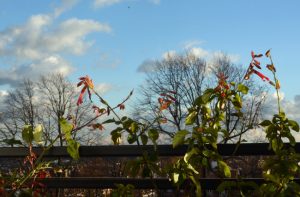
Although I do continue to yearn from time to time for a more ordered state of affairs, including the sophistication of matching bulbs in matching containers, this remains out of reach while I habitually cling on to too much in late Autumn and the planters are unavailable. I’m joined in this conspiracy by some of this year’s plants still producing occasional flowers; salvias, gera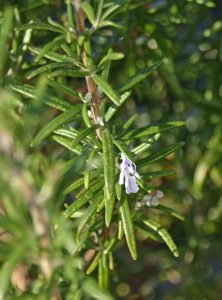 niums and roses close to the building, as well as the determined hellebores, and now to my surprise by the first rosemary flower, rather tentative but nevertheless showing a determined optimism. Down below the hollies are beginning to bear their berries, but up here it is another world which could be in danger of sliding past winter.
niums and roses close to the building, as well as the determined hellebores, and now to my surprise by the first rosemary flower, rather tentative but nevertheless showing a determined optimism. Down below the hollies are beginning to bear their berries, but up here it is another world which could be in danger of sliding past winter.
As at other times of year the plants and bulbs come mostly from local garden centres or on-line, with some additional horticultural gifts too. These are particularly welcome as I become aquainted, or reaquainted, with plants that I have ignored or neglected for one reason or another, some of which push me out of my comfort zone but then become permanent fixtures, others which I know and love but in time succumb to the harsh winds and limited planting space that all my plants are up against.
So in this season of planning and wondering I scour the catalogues and internet options, and think about other peoples’ gardens; what is essential, what can I squeeze in, what can I reconcile myself to. Some horticultural challenges I can easily avoid – in this neighbourhood the deer are all behind park railings, but planning for good plant combinations and succession planning is, I have discovered, somewhat challenging. At any one time only one or two plants may be contributing significantly to the party and there is also the added wish to be wildlife friendly, even if this isn’t a wild flower garden. Fortunately some plants (wild marjoram comes to mind) happily bridge the gap between town and country, wild and cultivated and somehow too, engender a sense of harmony and focus, or maybe that has more to do with personal memories and associations. On the other hand I’ve read that all it needs to turn ‘a city roof top into a verdant paradise’ is an orchard of potted fruit trees; admittedly the author was a nurseryman.
This year though there is a bonus. Careful negotiation has led to an agreement that a strip of the allotment will be available for cutting flowers – so early summer sweet peas, late summer dahlias and some mid-summer cosmos (which seem to produce flowers indefinitely even when confined to a pot) can, I hope, be anticipated, prepared and planted and will hopefully provide extra enticement to pollinators and a succession of flowers for indoors too. A virtuous exchange I hope for which I am extremely grateful.
I can’t unfortunately claim to be able to anticipate making elaborate arrangements with the blooms that bloom as I haven’t progressed much since I was given a ‘fair’ for the flower arranging I did at school. My memory is somewhat vague but as part of the ‘Duke of Edinburgh’s Award Scheme’ in those dim and distant days, there was a category called ‘home making’ or something similar. For some long forgotten reason I chose flower-arranging for which we were required to do a small vase arrangement and a large flower arrangement. All this was encouraged by the school and I suppose we were given some instructions or lessons. These details have faded but I do remember the examination day when we entered a room with vases, scissors, water I presume and all the flowers we had each brought in order to assemble the test displays. The other girls were mostly day-pupils and it seemed to me had either denuded large herbaceous borders or had gone to florists with deep pockets, and so arrived with foliage, flowers, variations of form and colour and a rather competitive air. As boarders the rest of us were only allowed to pick the rosebay willow herb from the field beyond the school – not quite fair I thought. The best we could do was cut the stems longer or shorter and the results were naturally not so impressive. The judge was the mother of one of the day-girls I seem to remember.
I did much better in another category when I chose life-saving and did quite well. Arguably a more useful skill.
and did quite well. Arguably a more useful skill.
Good fortune
As my roof-top garden is predominately orientated to the south, south-west it follows that my neighbours face east, north-east and have rather different trials and tribulations. Lunching together recently in a wonderful plant filled conservatory not far away (actually with thick mud underfoot as it had rained heavily the night before) the conversation moved around and for a while touched on my blog and recent posts http://retiringgardener.uk/2017/08/03/out-of-season/. In late summer I had written of my delight that my balcony was alive with ladybirds hopefully doing all they could to limit my aphid problem. I can see now that I was also revealing conspicuous gaps in my knowledge, because although I had registered that there were several different varieties, I hadn’t tried to make sense of this sudden arrival of so many visitors providing unexpected pest control. They hadn’t travelled far as my neighbours explained. Bought to control their own aphid problem the ladybirds had followed the sun and moved twenty yards south. Meanwhile the pigeon problem that had bothered them was gradually becoming less significant as the pigeons (wood pigeons I now know) were also moving south, attracted less by the sun than a new range of bird food that I had begun supplying. Another fair exchange I hope.
I remain seduced by the possibility of a verdant paradise, but the lay-out hereabouts does not suggest the possibility of a group of patio pots, amounting to an orchard, although I can manage a row of two pots (at best) and the south facing wall is vacant and waiting for occupancy.
There have been no converts to my earlier thoughts of acquiring a crab apple. Comments and messages, which I have been delighted to receive, have all prompted me to recognise that either I am not a crab-apple sort of person (possibly) or that I am unlikely to make use of the fruit when it arrives (probably). Not known for my jam-making skills I have been steered towards dessert apples and family trees, but the more recent alternative suggestion of a patio friendly apricot, Apricot ‘compacta’ a self-fertilising variety producing mouth ready fruit without the need for pruning, seemed irresistable, but others have got there before me and I will have to wait as it is now out of stock.
Instead I have a surprise in store as I was recently asked what I wanted for Christmas, a plant having already been generously decided upon. I suggested a dwarf fruit tree (unspecified) so who knows – I may yet have a crab apple and the beginnings of a verdant paradise.
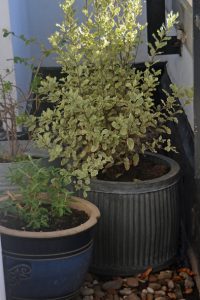
Happily too I have now discovered the new location of the insect homes. Still in the original construction, but buried under leaves and other garden litter, they have been blown towards a dry shady spot between the feet of a long flowering cistus, that was also happier when relocated, and an adaptable lavender that I move with the seasons. For now the lavender, an English variety so less particular about the damp air and cold winds, provides an appealing mound of grey foliage visible from indoors, but as the days get longer and the competition for space gets stronger, it may have to give way and accept a less central position. The leak is also fixed, the tiles have been replaced and two of the original containers have been joined by a pettosporum, which seems to be equally at home, albeit clipped and contained, on a raw windy balcony in the city, as it would be liberated in the milder spaces of the West Country.
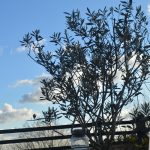


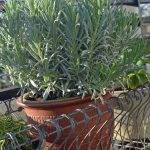

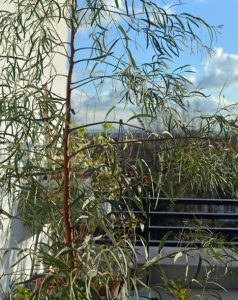
A suggestion for the insects: a couple of logs that are beginning to rot. All sorts of creepy crawlies like logs and they won’t blow about. I’m sure the 7 year old would be impressed.
Gord has just read your blog for the first time. ” Have you read Annie’s blog? She writes beautifully” says he with a faint hint of surprise in his voice.
The last time the seven year old and I got involved in logs was a rather hazardous business of removing a 14 foot long branch that had landed very close to a zip wire. But, a combination of opportunity (woods at the bottom of the garden) good timing (Boxing Day) and careful selection of some hopefully smallish pieces of wood (to build a log pile to scale) means your suggestion could be implemented very soon – I really appreciate the idea although I also wonder why I haven’t thought of it myself, particularly as the balcony is surrounded by large trees with their feet in the garden below, and the question of clearing the undergrowth has been a much discussed issue in our gardening group. A case of being unable to see the deadwood for the trees maybe?
Sounds and looks lovely and very absorbing. I agree that it’s beautifully written. Just one question: have you thought of a bird feeder?
Many thanks for your comment and for reading the blog – and yes, bird feeders are obvious but not entirely straightforward. I do now have one but not the full range of feeders, offering the à la carte menu, that I originally envisaged. My first purchase was carefully designed to allow small garden birds in and keep larger birds, particularly the rather aggressive magpies, out. But the small birds never took to it, partly I think because their escape route was not very obvious. I then went for some rather attractive small feeders which could be hidden amongst foliage, or be in the open, and allowed the smaller birds to perch and eat while on the look out. These were initially very successful. However, the feral pigeons, which normally frequent the north, city side of the building, discovered them and took over. This drove the smaller garden birds away and also risked increasing the problem of bird pooh on the cars down below. Undaunted I tried again, although the outlay on bird feeders was mounting. But I now do have a feeder which has been well worth the expense. With a dome to keep off magpies, and mounted in a narrow gap between a south easterly wall and a very free growing rambling rose, it is visited happily by wood pigeons, a wide variety of garden birds and even occasional wood-peckers. It is also ignored by the local parakeets. I am occasionally asked by someone close to me why I favour some birds more than others, which is not an entirely straightforward question to answer.
Don’t forget the Goldfinches!! Coming in, in droves, in the countryside! I have a ground feeder as well and it takes a little time for them to realise that they can get in and out of the “cage” – also if you like “pretty” birds, meal worms in the ground feeder does attract the wagtails – I have a grey one feeding daily – perhaps because of the pond – Happy New Year Ann
Ah! – so perhaps my mealworms need to be offered in another feeder at ground level too? Actually I did wonder if I’d glimpsed a visiting wagtail just before Christmas but didn’t really dare to hope. I will look more closely in the future. But no luck with goldfinches so far, in spite of a dedicated nigella seed feeder. Maybe the surrounding gardens are offering more cover or a better menu? There is another possible explanation – since ornithology is only a relatively recent interest, identification of visiting birds involves a rather complicated sequence of forwarding photos to the family experts and waiting for the answers to come back. This is sometimes made even more complicated because the family experts don’t always agree on the finer details. I wonder which other visitors I might have missed?